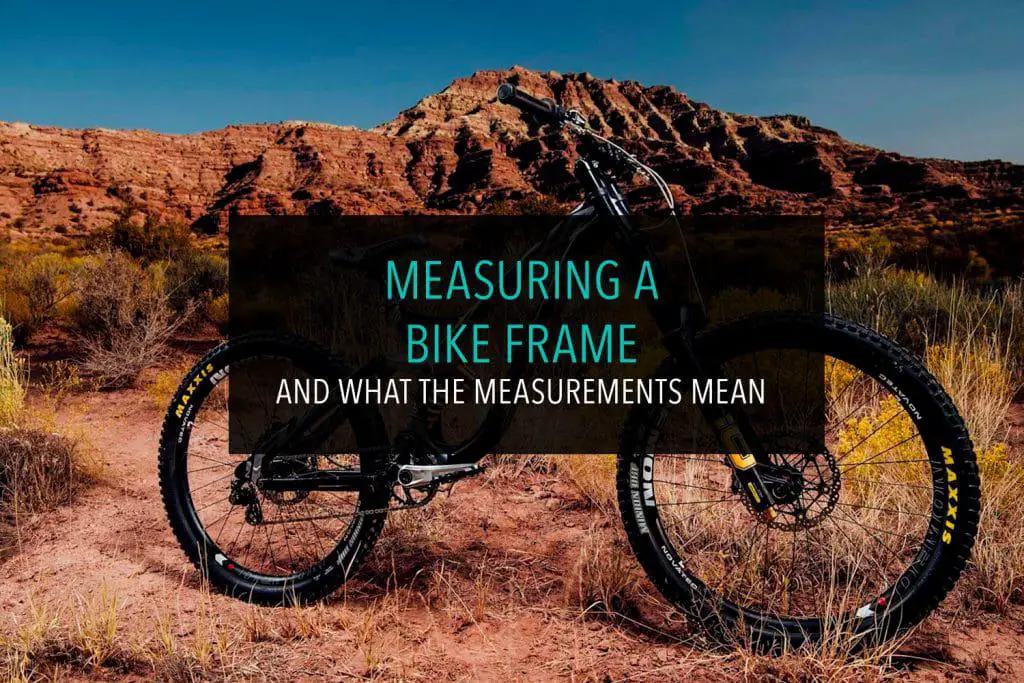Bike measurements are so important for so many reasons, but for the most part, it can seem daunting trying to understand what to measure and what the measurements mean. I will go over common measurement methods and describe what each measurement will tell you.
Bicycles are measured using three common methods:
- Overall Sizing – Small, Medium and Large
- Tube Lengths – Head Tube, Seat Tube, and Top Tube
- Reach and Stack – Horizontal Distance between the crankshaft and head tube, Vertical Distance between the crankshaft and Head Tube
Ok, more than likely the number one made sense, but I know numbers two and three are a little more complicated. No worries, I’ll break it down further down.
Fundamentals of Bike Measurements
Bike measurements are really at three levels. Those three measurement methods that I gave are ranging from easiest to most complicated.
The only problem is, that the easier the measurement system is, the less accurate it is too. So I’ll go through each type of measurement and show you how to measure your bike using each method.
Before we get started, if you are looking to find the measurements of your bike, first check for a sticker on the seat post.
The seat post is the tube that the seat sits on.
Some models and brands of bikes will have the measurements put on the bike when it is manufactured.
If your bike doesn’t have that sticker, no worries, I’ve got you covered.
Overall Sizing
The overall sizing system is really the least effective system but it can work in some situations.
This system uses generalized terms to describe the size of the bike. These sizes are extra small, small, medium, large, and extra large. You get the idea.
You can probably see why this is the least effective way to measure a bike. Since the sizes are so general, you are not very likely to find a bike that is a perfect fit for you because there are no specific measurements.
There are a few pros to this type of measurement. It can be done it pretty much 10 seconds. This is usually a good way to size a bike for a child. Since a child does not need a perfectly tailored bike.
When you are looking to purchase a bike, the small medium and large method will probably include some direction on the typical age or height that would make the best fit.
Even if you are an adult, looking for a bike that won’t break the bank, you will probably see this type of sizing for cheaper bikes.
If you are trying to measure your own bike this way, you can probably decide where your bike falls without even getting out a tape measure.
All in all, I would sum this method up with the word, simplicity.
Tube Length Measurements
This is the more in depth, but also an intermediate way to measure a bike. There are a few parts of the bike you will need to measure, but all of the measuring processes are fairly simple.
The reason that this is not the best way to measure bikes is that this method was designed for older bikes. When bikes were first being made, they were made using hard angles and straight frames.
Bikes that were built like this could easily be measured using this method, but today, newer modes of bikes are designed using more curved frames and updated specifications. The updates to the bikes have caused this method to become slightly outdated in some cases.
Don’t get me wrong, this method still works in most cases, it will give you pretty close measurements for your bike. Here are the three measurements you will need to do.
Seat Tube Length
You will need to know the names of the different tubes before you pull out your tape measure. The first and easiest is the seat tube. It is exactly what it sounds like.
It is the tube that your seat connects on to. Now for this measurement, you will also need to know another term. It is called the Crank Shaft. The easiest way to find the crankshaft is to grab your pedal and find where it connects to the bike. That connecting point is called the crankshaft.
Once you find the crankshaft you will be ready to measure. Keep in mind that you will want to take down the measurements in inches and also in centimeters.
Measure
To measure the seat tube length you need to place the tip of the tape measure on the crankshaft point. Extend the tape measure up the tube to the point where the top horizontal tube is welded to the seat tube. You will take the measurement from the top of that weld.
Take down the measurement in inches and centimeters.
The seat tube length will help you understand the height of the bike. You will also be able to see the influence of raising or lowering your bike saddle will have.
Seat height is a determining factor of what muscle groups you will use while riding.
Top Tube Length
Now you are ready to measure the top tube. The top tube is the one that you straddle when you are standing over the bike. In order to take this measurement, you will need to know another term. The term is the head tube. The head tube is the tube that the handlebars are on.
The top tube (the one you straddle) connects from the seat tube to the head tube.
Measure
To take this measurement, you will place the tip of the tape measure at the weld were the seat tube and the top tube meet. The tap measure should be right in the middle of the connection.
Extend the tape measure to the head tube and you will take the measurement from the center point where the top tube is welded to the head tube.
Take down the measurement in centimeters and inches
The top tube measurement gives you an idea of how far the seat is from the handlebars. If the top tube is too short, your legs won’t have room to pedal, and if it is too long, you will have to lean too far forward. This can cause back pain.
Head Tube Length
This measurement will be the smallest of the three. For this measurement, you will place the tip of the tape measure right at the point where the handlebars connect to the head tube.
Extend the tape down to the point where the head tube branches out to hold the front tire. You will take your ending measurement strait from this branching point.
And remember! Take down the measurements in inches and centimeters.
The head tube length determines how high up your handlebars are. Higher handlebars mean less leaning, while lower handlebars can mean more leaning.
These three measurements together are important in relation to a cyclists measurements. In order to find a perfect fit, the cyclist needs to be measured and matched to a bike correlating with his/her measurements.
There are a few caveats to these measurements. If your top tube is not parallel to the ground you will have to use what is called an “Effective Top Tube Measurement” You will then have to also measure for an “Effective Seat Tube Measurement”
Ill briefly explain these below.
Slanted Top Tube (Effective Top Tube)
Basically, you will need a long craftsman level for this measurement. (The one with the floating bubbles)
You will take the level and place it at the weld point of the top tube and the head tube. Hold it level against the frame of the bike and mark on the SEAT TUBE where the level is.
You are creating an imaginary top tube that would be parallel to the ground. Now measure from the weld point of the head tube and top tube to the level marked point on the seat tube. That is your “Effective Top Tube” Measurement.
Effective Seat Tube Measurement
From here, finding the effective seat tube measurement is easy. You will place the tip of the tape measure at the crank shaft like before, but now your ending measurement will be at the level marked point from when you measured for the effective top tube.
If you need to, you can use the level again to find that imaginary top tube. Mark the seat post again and measure to that point.
Now you have your effective seat tube measurement!
Reach and Stack
The last type of measurement is said to be the most accurate, it is also the most modern. It works well for newer bikes with curved or special frames.
The very basics of this measurement is making a right angle from your crankshaft to your head tube (at the handlebar connecting point)
The reach measures the horizontal distance from your crankshaft to the head tube
The stack measures the vertical distance from the crankshaft to the head tube.
In order to measure your bike using this method, it is suggested that you prop the bike against a wall. Then you will want to measure these distances to create a right angle. (See the infographic)
I would suggest using an angle tool to make sure your measurements are correct.
These measurements are more commonly used than ever. If you are looking to measure your bike out of curiosity that is fine, your measurements will work.
But if you are looking to buy a nice new bike, you might think about being sized by a professional.
Other Important Measurements
Another common measurement you will see is the tire size. Tire size does give you an idea about the average size of the bike frame, but mostly this measurement is good for picking out the right tubes 🙂
Another measurement you might see if you are a little more serious is the chainstay length, this is the length of the bar that runs next to your chain. These vary in length depending on the style of the bike.
Good luck in your cycling and Happy riding!!



